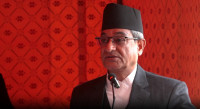National
Parliament Secretariat says no-confidence motion against Oli was registered after House dissolution decision
The Secretariat says registration was done at 3:30pm on Sunday, contrary to reports that suggested the time to be 10:30am.
Post Report
Days after the KP Sharma Oli government dissolved the House of Representatives, the Parliament Secretariat said on Wednesday that a no-confidence motion against the prime minister on Sunday was registered at 3:30pm.
Issuing a statement on Wednesday, the Parliament Secretariat said that its serious attention has been drawn to reports about the timing of the registration of the no-confidence motion.
“The motion was formally registered at the business advisory section of the Secretariat at 3:30pm on December 20 after the Speaker went through it,” reads the statement.
On the morning of December 20, Prime Minister Oli had called an emergency meeting of the Cabinet, which then had decided to make a recommendation to the President that the House of Representatives be dissolved. Later in the day, at around 3pm, the President had endorsed the Cabinet recommendation for dissolving the House.
Various media outlets, including the Post, reported that as many as 90 parliamentarians belonging to the Pushpa Kamal Dahal faction had registered the motion before the President endorsed the House dissolution recommendation.
A document was circulated to the media and it had also surfaced on social media on Sunday evening, claiming that the motion was registered at 10:30 am.
National Assembly chair Ganesh Timilsina’s secretariat, however, had refuted the reports.
In the Nepal Communist Party, which now has split in two along Oli and Dahal factions, Timilsina is considered to be close to Oli while Speaker Agni Sapkota has close relations with Dahal.
The time of the registration of the no-confidence motion attracted debate given a precedent in Nepal in relation to the dissolution of the House.
Had the motion been filed at 10:50, it would have been ahead of the House dissolution, which actually happened only after the President endorsed it.
Talking to the Post on Monday Balaram KC, a former justice at the Supreme Court, said that the time of the registration of the no-confidence motion and decision of the Oli Cabinet to dissolve the Lower House could be a strong basis for the final verdict.
In 1995, when the apex court overturned the decision of then Manhoman Adhikari-led government’s decision to dissolve Parliament, one of the strong points the bench presented was that a no-confidence motion had already been registered in Parliament to the House dissolution, thereby, giving an opportunity for the House to find an alternative to his government.
KC, who was a practicing lawyer then, had defended the Adhikari government’s move in the court.
Nonetheless, the House dissolution recommendations by the Adhikari government and Oli government were made under different constitutions.
The current constitution of Nepal does not allow a majority prime minister to dissolve the House. Lawyers and experts on constitutional affairs have said that Articles [76 (1), (7) and 85] cited by the Oli government and the Office of the President to dissolve the House do not provide any ground for the dissolution of the House.
The matter is now with the Supreme Court.




 7.12°C Kathmandu
7.12°C Kathmandu














